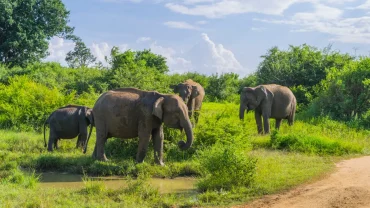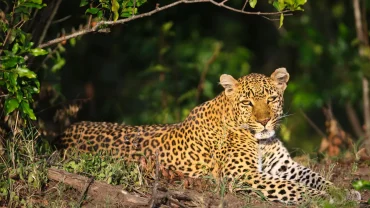Nestled along the southern coast of Sri Lanka, Bundala National Park is a haven of natural beauty and biodiversity. While Sri Lanka boasts several world-famous national parks, Bundala often flies under the radar, making it a hidden gem for wildlife enthusiasts and nature lovers alike. In this blog post, we’ll take you on a virtual journey through the park’s rich ecosystem, vibrant wildlife, and breathtaking landscapes that make Bundala a must-visit destination for anyone seeking an authentic Sri Lankan safari experience.
The Essence of Bundala National Park
Established in 1991 as a national park, Bundala spans approximately 6,200 hectares, providing a perfect blend of coastal wetlands, saltwater lagoons, and dense vegetation. Located about 245 kilometers south of Colombo and just 20 kilometers east of the bustling town of Hambantota, the park lies at the crossroads of two distinct ecosystems—coastal and dry zone.
What sets Bundala apart from other parks in Sri Lanka is its status as a designated Ramsar Wetland Site, protecting its importance as a critical stopover point for migratory birds traveling along the East Asia-Australasia Flyway. With its lush lagoons and salt flats, it serves as an essential sanctuary for over 200 species of birds, making it a top destination for birdwatchers.
A Birdwatcher’s Paradise
Bundala National Park is one of the best places in Sri Lanka to observe a wide variety of avian species, both resident and migratory. The park’s wetlands are teeming with birdlife, and for avid birdwatchers, it offers a once-in-a-lifetime opportunity to spot rare species such as the Greater Flamingo, Purple Heron, and Lesser Adjutant Stork.
The flamingo population here is particularly impressive, with hundreds of these graceful birds flocking to the park’s shallow lagoons, particularly during the dry season between November and April. In addition to flamingos, visitors can spot a plethora of other waterfowl like Cormorants, Pelicans, and Egrets, which thrive in the wetlands of Bundala.
Beyond waterbirds, the park also provides shelter to numerous raptors like the Peregrine Falcon and Black-shouldered Kite, as well as terrestrial species like the Sri Lanka Junglefowl, the island’s national bird. Whether you’re a casual bird lover or an experienced birder, Bundala offers an incredible range of birdlife to discover.
A Safari Like No Other: Bundala’s Wildlife
While Bundala is a birdwatcher’s paradise, it’s not just birds that call this park home. The park’s diverse ecosystems—ranging from freshwater marshes to scrubland—support a wide variety of wildlife. Adventurers can embark on safari drives to spot some of Sri Lanka’s most iconic species.
The park is home to large populations of Elephants, and sightings of these magnificent creatures in their natural habitat are one of Bundala’s key attractions. As you traverse the park, keep an eye out for herds of elephants grazing along the water’s edge or bathing in the lagoons. It’s a magical experience that brings you up close to Sri Lanka’s charismatic megafauna.
Bundala is also home to Leopards, Wild Boar, Mongoose, Crocodiles, and various species of monkeys, including the Toque Macaque and the Grey Langur. For those interested in reptiles, the park is a great place to spot various species of snakes, including the Python and Russell’s Viper.
Flora and Fauna: A Biodiversity Hotspot
The park’s rich biodiversity is not just limited to its wildlife but also includes its vibrant plant life. Bundala’s flora is primarily made up of dry-zone forest, coastal vegetation, and salt-tolerant mangroves, each contributing to the unique landscape of the park. Coconut palms, mango trees, and tamarind trees can be found in the park’s interior, while the coastal belt is dominated by salt marshes and mangrove forests, home to a myriad of plant and animal species.
The seasonal wetlands of Bundala create the perfect breeding ground for various species of fish and crustaceans, which, in turn, attract a wealth of wildlife. This rich web of life ensures that Bundala is an ecologically important site that deserves protection and conservation efforts.
Activities and Things to Do
A visit to Bundala National Park is a delightful combination of exploration, relaxation, and education. Here are some of the top activities to enjoy:
1. Safari Tours
The best way to explore Bundala is on a guided safari tour. Several operators offer Jeep safaris that take you through the park’s most scenic areas, including the salt flats, lagoons, and forested sections. With an experienced guide, you’ll be able to spot wildlife from a safe distance and gain insights into the park’s ecosystems.
2. Birdwatching
If you’re a bird lover, consider booking a dedicated birdwatching tour, where expert guides will take you to the park’s best birding hotspots. You’ll be able to observe rare species of birds, photograph them, and learn about their migratory patterns.
3. Photography
Bundala’s stunning landscapes and vibrant wildlife provide excellent opportunities for photographers. Whether you’re an amateur with a smartphone or a professional with a DSLR, there are plenty of opportunities to capture memorable shots of animals, birds, and nature in its raw beauty.
4. Nature Walks
For a more intimate experience of Bundala’s natural wonders, some tours offer walking safaris or nature walks where you can explore the park’s quieter corners on foot. These walks often provide the chance to get up close with the park’s flora and smaller wildlife, like insects and amphibians.
5. Relax and Unwind
Bundala National Park is a peaceful and less-crowded destination, making it an excellent spot for those seeking tranquility. After a day of exploration, unwind by enjoying the serene beauty of the park, watching the sunset over the lagoons, or simply soaking in the natural surroundings.
Best Time to Visit Bundala National Park
The ideal time to visit Bundala National Park is during the dry season, from November to April, when wildlife sightings are more frequent, and migratory birds, particularly the flamingos, are present in large numbers. The weather is warm, but the dry conditions make the park more accessible, especially the lagoons and salt flats.
How to Get There
Bundala National Park is easily accessible from Colombo (about 245 kilometers away) and Matara (around 80 kilometers). The closest airport is Mattala Rajapaksa International Airport, which is located about 20 kilometers from the park. You can reach Bundala by car, taxi, or local transportation.
Conservation Efforts
As an important wetland area and a UNESCO-listed Ramsar site, Bundala is under conservation protection. The Sri Lankan government and various conservation organizations are working tirelessly to preserve the park’s unique biodiversity. Efforts include safeguarding its ecosystems from human encroachment, managing its water levels, and ensuring sustainable tourism practices.
Final Thoughts: A Must-Visit Destination
Bundala National Park is one of Sri Lanka’s best-kept secrets. Its stunning natural beauty, incredible wildlife, and rich biodiversity make it an essential stop for anyone looking to immerse themselves in the island’s natural wonders. Whether you’re there for birdwatching, a safari, or simply to relax in nature, Bundala offers an unforgettable experience. Next time you’re in Sri Lanka, be sure to make time for this hidden treasure—you won’t regret it.




Comment (0)